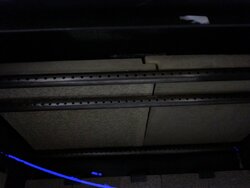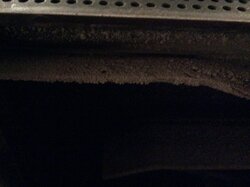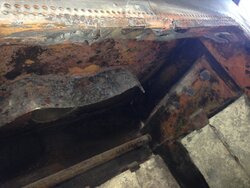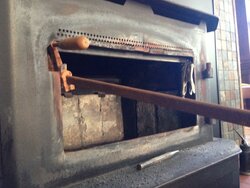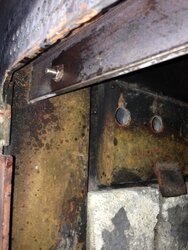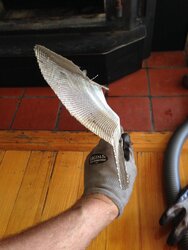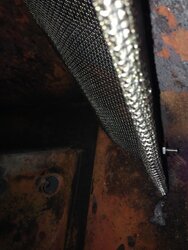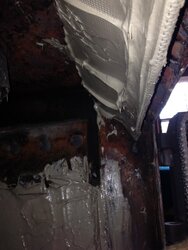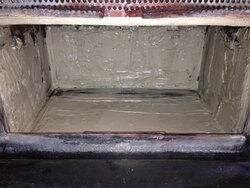Ok you are talking about face cords that is totally different so that is not the massive amount i was thinking. And no intact baffles is not the key to longevity but without them it will seriously hurt efficiency. But you are right if those are the original tubes you cant be over firing to much. But that fact of the matter is that you cracked your first stove prematurely and have warped many baffle sets and the deflector in 3 years you obviously are doing something wrong i am just not entirely sure what that is
Regency i3100 Insert Baffle
- Thread starter Benny4117
- Start date
-
Active since 1995, Hearth.com is THE place on the internet for free information and advice about wood stoves, pellet stoves and other energy saving equipment.
We strive to provide opinions, articles, discussions and history related to Hearth Products and in a more general sense, energy issues.
We promote the EFFICIENT, RESPONSIBLE, CLEAN and SAFE use of all fuels, whether renewable or fossil.
You are using an out of date browser. It may not display this or other websites correctly.
You should upgrade or use an alternative browser.
You should upgrade or use an alternative browser.
G Talbot
New Member
if we sold the stove we do it if the front manifold is cracked which is what will happen if you let it go then we submit it for a replacement stove.
It also seems to keep the intense heat off of that front manifold. But from the look of yours you need to reduce your internal temps or replacing that deflector will not save your stove
Thanks appreciate, bholler, will be attentive, but just checked temps, a 380 F on front top above door read and a 525 F hearth read, from a 2/3 toked down air intake and 2 log burn on hot coals ..will limp along till i can apply January fixes....unfortunately this year the fixes are to be done in the high use season...sigh...normally do this stuff in off season....got to hearth.com a little late, but did not expect such a rapid deterioration of the baffles and the deflector as have encountered in the past few weeks, while using and applying the same 12 year wood burning practices....sigh
Regency just a few days ago, saw the same pictures you did, their reply was that it was normal wear and tear for a 3100, there were no problems, just move the baffles more to center to cover gap......sigh
manufacturing reps, little concern other than selling new units, my how times have changed
Last edited by a moderator:
davidmsem
Minister of Fire
I'm confused....I have a new i3100 and the stones on top (baffle) have a slight curve. Is there an issue in performance or operability that you are seeing? I'm not sure what the complaint is, help me understand.
Ps....do the stones on top get pushed together in the center or out to the sides?
Ps....do the stones on top get pushed together in the center or out to the sides?
G Talbot
New Member
I'm confused....I have a new i3100 and the stones on top (baffle) have a slight curve. Is there an issue in performance or operability that you are seeing? I'm not sure what the complaint is, help me understand.
Ps....do the stones on top get pushed together in the center or out to the sides?
You say a new I3100, was it installed this 2014 year, and are you in a 1st season of burn?
The Regency manual recommends that the baffles be fully pushed back and totally tight to the sides...if all is well you should be left with a 1/8-1/4" inch gap in the center baffle overlap...below is a picture of how it should look....
Attachments
G Talbot
New Member
Ok you are talking about face cords that is totally different so that is not the massive amount i was thinking. And no intact baffles is not the key to longevity but without them it will seriously hurt efficiency. But you are right if those are the original tubes you cant be over firing to much. But that fact of the matter is that you cracked your first stove prematurely and have warped many baffle sets and the deflector in 3 years you obviously are doing something wrong i am just not entirely sure what that is
bholler, truly appreciate your help and opinions, appreciate your sharing of helpful experience and interest in and thanks for your suggestions and opinions from having seen many units of this type in operation.
bholler, am smiling, in 2011, my i3100 cracked in the upper corner, primarily on the door side, with the very start of a crack failure on the opening side upper corner. You might believe that there was a very extensive study done of me and my processes and a requirement with many, many pictures, before a claim acceptance and a replacement unit was provided. I surmised in the end that i may possibly not have been the only one, there were possibly others?
Today, i had another revelation about a recent change to 3100. Have a really close look at a new 2014 model 3100 and the upper corners of the facelplate. I noticed today that there are now a slight mark/indentation on the units face, of about 1/2" or so in those 2 upper corners...darn i wish i had taken a picture today.
That indentation does/did not exist on my i3100's and in 2011 the problem and concern was there, are they fixing another potential engineering problem.
I find it sad that Regency may not be sharing openly, especially with dealers, areas to inspect and monitor, which is likely why engineering changes may be happening....sigh
as a proud owner and quite dependant on my unit, i have no reason to want to damage my unit, in fact i may be more aware than many and frequently monitoring and questioning potential issues...I first reported baffle issues in 2004, as well as the deflector deformation and a few times after that. I have not had a baffle replacement claim refused yet....suspect Regency knows stuff and probably know what serial number sequences that may have reported issues...engineering changes are driven by discoveries reported by dealers and customers...improvements seem slow and are likely a numbers game of profits....sigh
davidmsem
Minister of Fire
You say a new I3100, was it installed this 2014 year, and are you in a 1st season of burn?
The Regency manual recommends that the baffles be fully pushed back and totally tight to the sides...if all is well you should be left with a 1/8-1/4" inch gap in the center baffle overlap...below is a picture of how it should look....
Thank you....this is how the unit is setup. It runs great.....well insulated flue and the like.....first impression: love it!
G Talbot
New Member
Have decided that my Regency I3100 as of this morning is now off completely, until fixes are applied.
Stove deemed as unhealthy, with a growing concern for the longevity of the stove, as well as safety in unattended burn.
Have attached a Picture below of the now very visible issues, regarding baffles and deflector deterioration, been burning small fires and limping in the last few days, while working out a plan. Currently living an unacceptable status with cold coming and a high dependancy of the 3100 as our primary heat source.
To address my concerns, will be performing the following steps to restore the 3100 to a deemed "healthy" status:
1)Replace the ceramic baffles (063-955) and will perform an indepth comparison of the new baffles to the 2 month old baffles installed in the 3100 that are distorting badly and very rapidly.
2) Dissasembly and Close Inspection of the 3/4" air tubes, tubes 1-3 from front....will be compared to new, in looking for any possible changes in the existing air tubes.
3) Investigating the retrofit to my older 3100 (same for I3100 or F3100) of a new replaceable deflector, Regency part # 820-484C, a stainless deflector (a 2014 Regency redesign?), that clips onto bolts attached to the upper front face of the 3100 series stove. Am also hoping that Regency might have a retrofit kit (and provide some guidance) for retrofitting this part onto my 2011, I3100 unit, which currently has a spot welded steel deflector, in pretty bad shape. Seems to me that bold placement will have little tolerance for assembly/dissassembly.
4) May perform a change of the door gaskets, although they seem do seem to be very airtight.
Am currently thinking that an intact deflector may be a very important component of the Regency stove, in ensuring a healthy longevity.
Luckily we are hitting a warm spell with a few days of 0 Celcious and above degrees of outside temps.
Am really hoping to have peace of mind on the 3100 and just in time for the peak heating season of Jan-Feb.
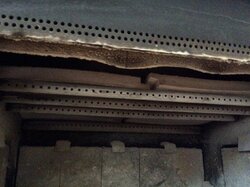
Stove deemed as unhealthy, with a growing concern for the longevity of the stove, as well as safety in unattended burn.
Have attached a Picture below of the now very visible issues, regarding baffles and deflector deterioration, been burning small fires and limping in the last few days, while working out a plan. Currently living an unacceptable status with cold coming and a high dependancy of the 3100 as our primary heat source.
To address my concerns, will be performing the following steps to restore the 3100 to a deemed "healthy" status:
1)Replace the ceramic baffles (063-955) and will perform an indepth comparison of the new baffles to the 2 month old baffles installed in the 3100 that are distorting badly and very rapidly.
2) Dissasembly and Close Inspection of the 3/4" air tubes, tubes 1-3 from front....will be compared to new, in looking for any possible changes in the existing air tubes.
3) Investigating the retrofit to my older 3100 (same for I3100 or F3100) of a new replaceable deflector, Regency part # 820-484C, a stainless deflector (a 2014 Regency redesign?), that clips onto bolts attached to the upper front face of the 3100 series stove. Am also hoping that Regency might have a retrofit kit (and provide some guidance) for retrofitting this part onto my 2011, I3100 unit, which currently has a spot welded steel deflector, in pretty bad shape. Seems to me that bold placement will have little tolerance for assembly/dissassembly.
4) May perform a change of the door gaskets, although they seem do seem to be very airtight.
Am currently thinking that an intact deflector may be a very important component of the Regency stove, in ensuring a healthy longevity.
Luckily we are hitting a warm spell with a few days of 0 Celcious and above degrees of outside temps.
Am really hoping to have peace of mind on the 3100 and just in time for the peak heating season of Jan-Feb.

KB007
Minister of Fire
That deflector looks like most. Mine is the same. Shop installer said it was pretty typical and not a big performance issue.
I looked at my baffles and they don't overlap quite as much, more like there is a 1/4 " gap overall. Definitely not the same warp you have there. I did notice I've knocked a couple of chunks out, so prolly time to replace them. Mine ar either 4 or 5 years old now, so prolly time to replace.
I looked at my baffles and they don't overlap quite as much, more like there is a 1/4 " gap overall. Definitely not the same warp you have there. I did notice I've knocked a couple of chunks out, so prolly time to replace them. Mine ar either 4 or 5 years old now, so prolly time to replace.
G Talbot
New Member
3100 ceramic Baffles
changed my baffles yesterday, city dealer stripped his demo to accomodate my immediate need, premium service for premium $ and i am ok with that.
So after total dissasembly and full inspection of the unit, reassembled my 3100 and it is back up to operation on new baffles .. also flipped in a a couple of different spare air tubes to be sure.....and was surprised to find that one of the air tubes in the unit, was actally a 1/4" shorter than the others? might have been the one popping out on occasion from expansion and vibration....probably and am crossing my fingers
Observed that new baffles are now naturally drying with a curve (invard concave on the rough side), a recent issue since 2013 methinks. The new ones (just acquired) have a beginning of a curve already (from sitting in a demo unit and before the very 1st fire). I can just imagine their status and condition after 5-6 cords of heat and by February....we'll see then.
What is nice is that the new baffles are 28.5 centimetres in width on the rough side x2, vs the previous set at 28 centimetres. New baffles are therefore providing 1 centimeter more coverage overall and when assembled, the unit is now back to a 1/4" gap...picture below. Begs the question: Are there 2 different moulds being used in ceramic baffle manufacturing, 2 different sub-manufacturers, quite a mystery to me. If replacing baffles and if you have a choice, suggest that the 285 mm baffle is a better fit, both seem to have the (063-955) code.
To note that Ceramic baffles are delicate, especially once they have been used and heat dried. Be very careful on removal for chimney sweep as that handling alone can easily chip and crack. As an example, brought my 2 month old baffles to dealer for comparison, they were in a box and cracked/chipped just from vehicle transport.
Suggest from my experience that for the folks often using older 3100 units, (2002-2013), that are ignoring a deteriorating 3100 deflector condition and/or poor baffle condition may cause much more and larger issues. My original I3100 was in the 1st thousand produced and there are likely more than 20,000 3100's series units out there now, assuming that 20-30% are likely getting frequent use, a greater number of people will be encountering issues, jeoparding longevity.
New 3100 users may benefit from the 3100 redesign (differences i could see from a examining a new 3100 demo unit)
Doors now Bolted on frame vs. previously welded door hinges
2 stamps on face in upper corners
New changeable deflector design, stainless vs. the spot welded steel plate in previous design
The 3100 is a great stove and with inspection and tweaking, a fantastic unit.
merry Chistmas all
Gil
changed my baffles yesterday, city dealer stripped his demo to accomodate my immediate need, premium service for premium $ and i am ok with that.
So after total dissasembly and full inspection of the unit, reassembled my 3100 and it is back up to operation on new baffles .. also flipped in a a couple of different spare air tubes to be sure.....and was surprised to find that one of the air tubes in the unit, was actally a 1/4" shorter than the others? might have been the one popping out on occasion from expansion and vibration....probably and am crossing my fingers
Observed that new baffles are now naturally drying with a curve (invard concave on the rough side), a recent issue since 2013 methinks. The new ones (just acquired) have a beginning of a curve already (from sitting in a demo unit and before the very 1st fire). I can just imagine their status and condition after 5-6 cords of heat and by February....we'll see then.
What is nice is that the new baffles are 28.5 centimetres in width on the rough side x2, vs the previous set at 28 centimetres. New baffles are therefore providing 1 centimeter more coverage overall and when assembled, the unit is now back to a 1/4" gap...picture below. Begs the question: Are there 2 different moulds being used in ceramic baffle manufacturing, 2 different sub-manufacturers, quite a mystery to me. If replacing baffles and if you have a choice, suggest that the 285 mm baffle is a better fit, both seem to have the (063-955) code.
To note that Ceramic baffles are delicate, especially once they have been used and heat dried. Be very careful on removal for chimney sweep as that handling alone can easily chip and crack. As an example, brought my 2 month old baffles to dealer for comparison, they were in a box and cracked/chipped just from vehicle transport.
Suggest from my experience that for the folks often using older 3100 units, (2002-2013), that are ignoring a deteriorating 3100 deflector condition and/or poor baffle condition may cause much more and larger issues. My original I3100 was in the 1st thousand produced and there are likely more than 20,000 3100's series units out there now, assuming that 20-30% are likely getting frequent use, a greater number of people will be encountering issues, jeoparding longevity.
New 3100 users may benefit from the 3100 redesign (differences i could see from a examining a new 3100 demo unit)
Doors now Bolted on frame vs. previously welded door hinges
2 stamps on face in upper corners
New changeable deflector design, stainless vs. the spot welded steel plate in previous design
The 3100 is a great stove and with inspection and tweaking, a fantastic unit.
merry Chistmas all
Gil
Attachments
Forum reader
New Member
I've had a freestanding 3100 since 2005. Tried to replace baffles this year and had a heck of a time locating a set. Waited for weeks to hear back from my dealer and finally gave up and replaced baffles with a 3/8 steel plate that is approximately 1" short of stove width, so there's a 1/2" gap on each side of the baffle. I think this is causing my stove to consume more wood and burn less efficiently. It seems these baffles are hard to get, which is my one complaint with this stove. I've heated a 3200 sq. ft. story and a half house almost exclusively with this stove for 10 years. I keep a thermometer on the chimney 18" up form the stove top and keep the chimney temp at 200 degrees F minimum. I sweep once a year at the end of the season and get about a large coffee can of creosote on average.
The past couple years, even before replacing the baffles, I've noticed that to keep flue temp up, I often have to burn with door cracked open. Any input as to why? Is it just the fact that baffles were worn out? Seems like I'd have higher flue temps if that's the case, not lower. Love this thread. It's been very informative. Even though I've burned for a long time and been through at least 55 full cords of wood, I still feel like I don't know what I'm doing. I'm open to any input you can give. Even tell me how stupid I am if you want. I'm thick skinned, willing to listen, and want to learn.
On a side note, I'm thinking of starting a company to make these darn baffles cause there seems to be a pretty high demand for them and not a lot of supply!!
The past couple years, even before replacing the baffles, I've noticed that to keep flue temp up, I often have to burn with door cracked open. Any input as to why? Is it just the fact that baffles were worn out? Seems like I'd have higher flue temps if that's the case, not lower. Love this thread. It's been very informative. Even though I've burned for a long time and been through at least 55 full cords of wood, I still feel like I don't know what I'm doing. I'm open to any input you can give. Even tell me how stupid I am if you want. I'm thick skinned, willing to listen, and want to learn.
On a side note, I'm thinking of starting a company to make these darn baffles cause there seems to be a pretty high demand for them and not a lot of supply!!
WES999
Minister of Fire
Try here for the baffles, I think this is the one for your stove.
http://www.woodmanspartsplus.com/939/736621/Unassigned/Regency-Stove-Baffle-Set.html
I don't think steel plates with a gap on the side will work properly, it will let a lot of heat go up the flue.
If you stove won't burn without cracking the door, something is wrong. I have the smaller F1100 and with dry wood, I burn with the door shut tight and the air closed or almost closed.
Check for:
Wet wood, poor draft, plugged air passage, dirty chimney.
http://www.woodmanspartsplus.com/939/736621/Unassigned/Regency-Stove-Baffle-Set.html
I don't think steel plates with a gap on the side will work properly, it will let a lot of heat go up the flue.
If you stove won't burn without cracking the door, something is wrong. I have the smaller F1100 and with dry wood, I burn with the door shut tight and the air closed or almost closed.
Check for:
Wet wood, poor draft, plugged air passage, dirty chimney.
Forum reader
New Member
I don't think it's a wood issue. Have well aged ash, black wlanut, and cherry. Chimney is in good shape and I replaced firebrick lining inside of stove this year. I have the same issue as stated above with air deflector. It has warped and separated from stove wall. I don't know why it doesn't seem to build heat like it used to. Stove looks good and everything seems to be pretty much like it was when installed. Is there anything that could block the air intake? Is there something that I should be cleaning that I'm not? I've done just about everything according to the owners manual.
Thanks for the link. I've already ordered a new set of baffles. I'll get them in the stove as soon as I receive them. I love burning wood for many reasons and would really like the stove to last another 20 years. Do you think having the steel plate in there could damage the stove?
Thanks for the link. I've already ordered a new set of baffles. I'll get them in the stove as soon as I receive them. I love burning wood for many reasons and would really like the stove to last another 20 years. Do you think having the steel plate in there could damage the stove?
Last edited:
G Talbot
New Member
I've had a freestanding 3100 since 2005. Tried to replace baffles this year and had a heck of a time locating a set. Waited for weeks to hear back from my dealer and finally gave up and replaced baffles with a 3/8 steel plate that is approximately 1" short of stove width, so there's a 1/2" gap on each side of the baffle. I think this is causing my stove to consume more wood and burn less efficiently. It seems these baffles are hard to get, which is my one complaint with this stove. I've heated a 3200 sq. ft. story and a half house almost exclusively with this stove for 10 years. I keep a thermometer on the chimney 18" up form the stove top and keep the chimney temp at 200 degrees F minimum. I sweep once a year at the end of the season and get about a large coffee can of creosote on average.
The past couple years, even before replacing the baffles, I've noticed that to keep flue temp up, I often have to burn with door cracked open. Any input as to why? Is it just the fact that baffles were worn out? Seems like I'd have higher flue temps if that's the case, not lower. Love this thread. It's been very informative. Even though I've burned for a long time and been through at least 55 full cords of wood, I still feel like I don't know what I'm doing. I'm open to any input you can give. Even tell me how stupid I am if you want. I'm thick skinned, willing to listen, and want to learn.
On a side note, I'm thinking of starting a company to make these darn baffles cause there seems to be a pretty high demand for them and not a lot of supply!!
Forum reader
New Member
Maybe a new dealer is what I need. New baffles that I ordered on line should be here next week. When I put those in, I'll also drill and tap a couple holes so I can pull the air deflector/window washer back in place and keep it there.
Is there any way to get to and clean the air intake? I always just sweep the chimney, shovel and vacuum out all ash and creosote, and replace firebrick as needed. I do this in the spring after I'm done burning for the year. Should I be doing more?
Is there any way to get to and clean the air intake? I always just sweep the chimney, shovel and vacuum out all ash and creosote, and replace firebrick as needed. I do this in the spring after I'm done burning for the year. Should I be doing more?
that is pretty much it you can pull the blower and check under neath to see if there is allot of stuff under there but it is rarly a problem. I think your lack of heat output is probably due to the baffle. And you will probably need a new deflector once they warp they pretty much need replaced we have new ones made at a local machine shop or you could order a new one from regency
velvetfoot
Minister of Fire
Not that it means anything, but I just looked at my HI300, which is like the smaller I2400, I think, and it doesn't have that deflector.
Eric Swanson
New Member
We have a Regency I3100 that we've had for about 11/12 years and use continuously during the roughly 5-6 month heating season in New England.
My experience is that the stove is pretty cheaply made in some key areas, most notably the front deflector, which I've replaced about four times by bolting new 1/4" x 1-1/2" steel bars into the remaining remnants of the original deflector, at the ends.
Regency talks about "overfiring" as a way of sidestepping the issue that, in my opinion, the stove is not a great piece of manufacturing/engineering; there are more ways to overfire than I can list here.
I've found that regular use, with dry cordwood, with the intake shut down, with optimal practices per the instructions, still produces burned through metal at the top front of the stove, period.
I think that the design flaw lies in having the hottest, most concentrated flame directed at what is essentially unprotected plain steel. If it were all stainless steel, it might fare better, but it isn't.
One can't really be aware of the issue until you've owned the stove and used it continuously for awhile.
So, this year, when I replaced my deflector and patched up the baffles/firebricks, I also formed an armature of stainless steel mesh, https://www.amazon.com/gp/product/B01N4RCHFU/?tag=hearthamazon-20
covered the damaged top/front area, then plastered this with fire cement, thus covering the steel elements that had begun to burn through (even when used according to Regency's directions).
Voila! the area is now protected with a layer of cement, working like a custom-formed firebrick, which is keeping the steel protected. When I installed and "plastered" the stainless steel mesh, I ensured that the top passage remained open, so that the air-wash feature would continue to work.
I've attached photos of "before," the process, "during," and "after," before curing the fire cement. We've been using it for a month, since; it is working better than ever.
Also, my top baffles wore out over the years, were cracked and in pieces, etc. I laid them out on waxed paper on a flat sheet, fire cemented them together, using stainless steel mesh as "re-bar" across the joints, and took pains to reform the mating half-lap joint (again, with wax paper between the drying slabs, so that they didn't get stuck together).
They are better than ever. This approach has worked well, saved me money replacing firebricks/baffles, and is easily done by anyone who is a bit handy.
So, in summary, one can mend firebricks or baffles with stove cement, and improve the stove's design by covering the top front area with fire cement plastered onto a stainless steel armature. I hope that this helps another Regency owner...
With a little stove polish, the unit looks good as new and is actually better than new, with the new/improved protection of the vulnerable top/front area.
My experience is that the stove is pretty cheaply made in some key areas, most notably the front deflector, which I've replaced about four times by bolting new 1/4" x 1-1/2" steel bars into the remaining remnants of the original deflector, at the ends.
Regency talks about "overfiring" as a way of sidestepping the issue that, in my opinion, the stove is not a great piece of manufacturing/engineering; there are more ways to overfire than I can list here.
I've found that regular use, with dry cordwood, with the intake shut down, with optimal practices per the instructions, still produces burned through metal at the top front of the stove, period.
I think that the design flaw lies in having the hottest, most concentrated flame directed at what is essentially unprotected plain steel. If it were all stainless steel, it might fare better, but it isn't.
One can't really be aware of the issue until you've owned the stove and used it continuously for awhile.
So, this year, when I replaced my deflector and patched up the baffles/firebricks, I also formed an armature of stainless steel mesh, https://www.amazon.com/gp/product/B01N4RCHFU/?tag=hearthamazon-20
covered the damaged top/front area, then plastered this with fire cement, thus covering the steel elements that had begun to burn through (even when used according to Regency's directions).
Voila! the area is now protected with a layer of cement, working like a custom-formed firebrick, which is keeping the steel protected. When I installed and "plastered" the stainless steel mesh, I ensured that the top passage remained open, so that the air-wash feature would continue to work.
I've attached photos of "before," the process, "during," and "after," before curing the fire cement. We've been using it for a month, since; it is working better than ever.
Also, my top baffles wore out over the years, were cracked and in pieces, etc. I laid them out on waxed paper on a flat sheet, fire cemented them together, using stainless steel mesh as "re-bar" across the joints, and took pains to reform the mating half-lap joint (again, with wax paper between the drying slabs, so that they didn't get stuck together).
They are better than ever. This approach has worked well, saved me money replacing firebricks/baffles, and is easily done by anyone who is a bit handy.
So, in summary, one can mend firebricks or baffles with stove cement, and improve the stove's design by covering the top front area with fire cement plastered onto a stainless steel armature. I hope that this helps another Regency owner...
With a little stove polish, the unit looks good as new and is actually better than new, with the new/improved protection of the vulnerable top/front area.
Attachments
Last edited:
What temperatures are you running at? What chimney is it hooked to and how tall is it? Have you checked the seal on the door? That stove looks like it has been seriously abused. And honestly it is bad enough that I would not use it in my house. Did you try to have it replaced under warantee? I have a 3100 that is similar age and Burt 24/7 during the heating season in pa. And I have only replaced the deflector once. And the face is not cracked like yours. I also sell them and have only seen one stove as bad as yours. And that guy burnt it wide open all the time.We have a Regency I3100 that we've had for about 11 years and use continuously during the roughly 5-6 month heating season in New England.
My experience is that the stove is pretty cheaply made in some key areas, most notably the front deflector, which I've replaced about four times by bolting new 1/4" x 1-1/2" steel bars into the remaining remnants of the original deflector, at the ends.
Regency talks about "overfiring" as a way of sidestepping the issue that, in my opinion, the stove is not a great piece of manufacturing/engineering; there are more ways to overfire than I can list here.
I've found that regular use, with dry cordwood, with the intake shut down, with optimal practices per the instructions, still produces burned through metal at the top front of the stove, period.
I think that the design flaw lies in having the hottest, most concentrated flame directed at what is essentially unprotected plain steel. If it were all stainless steel, it might fare better, but it isn't.
One can't really be aware of the issue until you've owned the stove and used it continuously for awhile.
So, this year, when I replaced my deflector and patched up the baffles/firebricks, I also formed an armature of stainless steel mesh, https://www.amazon.com/gp/product/B01N4RCHFU/?tag=hearthamazon-20
covered the damaged top/front area, then plastered this with fire cement, thus covering the steel elements that burn through, even when used perfectly.
Voila! the area is now protected with a layer of cement, working like a custom-formed firebrick, which is keeping the steel protected. When I installed and "plastered" the stainless steel mesh, I ensured that the top passage remained open, so that the air-wash feature would continue to work.
I've attached photos of "before," the process, "during," and "after," before curing the fire cement. We've been using it for a month, since; it is working better than ever.
Also, my top baffles wore out over the years, were cracked and in pieces, etc. I laid them out on waxed paper on a flat sheet, fire cemented them together, using stainless steel mesh as "re-bar" across the joints, and took pains to reform the mating half-lap joint (again, with wax paper between the drying slabs, so that they didn't get stuck together).
They are better than ever. This approach has worked well, saved me money replacing firebricks/baffles, and is easily done by anyone who is a bit handy.
So, in summary, one can mend firebricks or baffles with stove cement, and improve the stove's design by covering the top front area with fire cement plastered onto a stainless steel armature. I hope that this helps another Regency owner...
With a little stove polish, the unit looks good as new and is actually better than new, with the new/improved protection of the vulnerable top/front area.
Eric Swanson
New Member
What temperatures are you running at? What chimney is it hooked to and how tall is it? Have you checked the seal on the door? That stove looks like it has been seriously abused. And honestly it is bad enough that I would not use it in my house. Did you try to have it replaced under warantee? I have a 3100 that is similar age and Burt 24/7 during the heating season in pa. And I have only replaced the deflector once. And the face is not cracked like yours. I also sell them and have only seen one stove as bad as yours. And that guy burnt it wide open all the time.
I don't know what the operating temperature is; only that we use seasoned cordwood and that we run the stove either completely shut down or, at most, 1/2" open (measuring the intake handle) per the instructions. It is hooked up to a continuous stainless steel stovepipe that runs straight up the inside of our masonry chimney. I'm not sure of the chimney height; the stove is on the first floor of a two-story bungalow. The pipe might be about 25 feet from the stove to the pipe's cap, as a guess.
MA is a bit farther north than PA; I'm not sure what the average difference in temperature might be.
I can only report that the insert has operated well, usually about 20 hours a day, seven days a week, 5-6 months a year, running nearly continuously. With the blower running (we are on our second blower motor; the bearings on the first gave out after about 5/6 years), it heats our entire 1100 sq ft two-story bungalow to a comfortable level; the gas only turns on for an hour or two in the very early morning, or in the mid-afternoons, when we are away and the fire has died, in the dead of winter.
I contacted the dealer and Regency, directly, after the first deflector burned through and they said, essentially, "Well, that does happen," but didn't offer any warranty claim; I haven't pursued it further.
The deformity of the front happened within the first year; the stove has been tight and has worked well since we got it, in spite of that. This was also explained by our dealer and Regency as normal wear and tear OR as evidence of abuse.
The manual is written such that any of the defects we have experienced are considered by Regency to be evidence of overfiring, even though I know that the stove has only been used according to the instructions. So, they have worded the manual such that any defects, such as those we experienced, void any warranty obligations on their end.
The stove has not been used with any fuel, in any way, other than outlined in the owner's manual. Despite that, the top/front area burned through and the face cracked.
I don't believe that this was due to overfiring, because I know how we treat the stove. I believe that it is due to our continuous use and Regency failing to adequately protect the top/front area from the heat.
The point of my post is that one can improve a design flaw/shortcoming in the stove by essentially covering the vulnerable top/front area with fire cement. I have the advantage of seeing and using the stove in person (sorry for the crummy photos
 ...).
...).I had a relatively unsatisfying time dealing with Regency when the stove was brand new. After that, I never considered applying to them for a warranty claim.
When we bought the unit, the sheet metal surround came, somewhat inexplicably and unapologetically, 1-1/2" taller/wider on the top than on the sides, which made the alignment with our tile surround (which had been laid out to Regency's planning specs for the surround) look terrible.
It took about 15-20 phone calls and and probably about 10 emails just to get a surround that was the dimensions promised in the literature. Regency's position was that, while the literature gave specified dimensions, all information was subject to change, without notice, and that they essentially had no obligations to help. They finally made a "custom" surround that was just the sizes promised.
After that ordeal, I have avoided dealing with Regency for anything other than parts, and that was through our very excellent local dealer.
I understand that as a dealer you may have some financial investment in promoting Regency; I'm not here to demean the brand or make it harder for anyone to sell Regency products. As owners, we feel that in terms of money saved on heat, we've done very well with our insert, as an investment.
I can only offer that we are scrupulous owners. Every year, we have the pipe cleaned at least once (sometimes twice) and the stove inspected. I've replaced gaskets both on the door and glass, which seal well. I have a backup set of gaskets, if needed. As I mention, I've replaced the full set of firebricks and baffles.
It is a relationship with a mechanical device. It is not a perfectly designed or exceedingly well-made object, but it is a very useful one. I think that I have figured out a way to overcome what I've found to be the weakest point in the I3100's setup; the top/front area.
The stove is sound and works better than ever. Regency offers a lot of bang for the buck. With regular maintenance, ours is heading into season 12 or 13 of daily use as our primary heat source; pretty good for a relatively inexpensive sheet metal stove, I think.
With my new, improved, fire-cemented-over-stainless-mesh-deflector area, I expect this unit to last for several more years of daily use. My only hope is to help another Regency owner improve their unit, should they experience the kind of burn through, in that area, that we've seen.
The photos and comments from other Regency owners, earlier in this thread, led me to think that photos of my fix might be helpful. I hope that they are.
I hope that my photos outline the process I followed. I'd be happy to answer any questions from those who care to replicate this improvement.
Last edited:
So you have no idea what temperature you are running your stove at but are sure you having over fired It? I think the biggest problem is your dealer. When the front deformed in a year they should have found out what was going on and corrected the problem. Yes the defector does deform sometimes but it is not normal and it is covered under warranty.
I have absolutely no financial interest in this your poor review will not effect my sales in the least. I just want to point out that I have sold many regencies. And worked on more what happened to yours is not typical at all. In fact it is very abnormal.
I have absolutely no financial interest in this your poor review will not effect my sales in the least. I just want to point out that I have sold many regencies. And worked on more what happened to yours is not typical at all. In fact it is very abnormal.
velvetfoot
Minister of Fire
Hey, the same thing happened to the my Hampton and the same reaction from the dealer (there was another thread on this). It burned right through. I had heard they replaced them with stainless, but this fix was not available to Americans. I want to thank you Erik for the great info.
Yes all new ones have stainless deflector. They have for a couple years now. We retro fit any that we sold that get damaged. Is the face of your stove distorted and cracked as well?Hey, the same thing happened to the my Hampton and the same reaction from the dealer (there was another thread on this). It burned right through. I had heard they replaced them with stainless, but this fix was not available to Americans. I want to thank you Erik for the great info.
Eric Swanson
New Member
So you have no idea what temperature you are running your stove at but are sure you having over fired It? I think the biggest problem is your dealer. When the front deformed in a year they should have found out what was going on and corrected the problem. Yes the defector does deform sometimes but it is not normal and it is covered under warranty.
I have absolutely no financial interest in this your poor review will not effect my sales in the least. I just want to point out that I have sold many regencies. And worked on more what happened to yours is not typical at all. In fact it is very abnormal.
Oh my.
I'm not trying to act like some sort of insert expert. I don't have a thermometer in my wood stove. Regency's manual doesn't say I need one. I never thought to buy one, frankly.
I'm saying that (a) we've used the stove exactly as instructed (b) the top/front metal has failed and I've replaced it, (c) Regency has acted like it was normal, (d) I devised a way to successfully and easily fix the problem, and (e) I believe that I've made the insert better than ever.
It sounds as if Regency recognized and fixed the deflector failure by changing it to stainless. A great move! If my stove had the stainless steel deflector, who knows what would have happened?
I have a way of fixing the burnout problem in the Regency insert. Others have apparently have the same problem based on this thread's title and preceding photos/discussion.
I've tried to help. Folks can use my fix if they want; I've tried to show how I did it.
Sorry if this isn't helpful. This is my first attempt at posting on this forum.
I have used my full name, posted my limited experience in good faith, and tried to be helpful. I'm not sure what else I can offer.
If having a stove thermometer and being a professional stove sales and maintenance person is a requirement here, I'm sorry to have transgressed. I've done my best to stick to my own, limited, honest experience as a mechanically inclined, well-intentioned, and committed Regency owner.
Last edited:
No it is not a requirement at all and without a doubt your review is very welcome. I am just trying to figure out what happens to your stove. By the looks of it it has been over fired many times. But we have no way to know because there are no temp readings. I am also curious to see how your repair holds up. In my experience furnace cement does not hold up well in applications like you have. I am really not trying to attack you at all and I apologise if it came off that way. I just feel the need to point out that your experience is not typical. Which is why I was asking for more info.Oh my.
I'm not trying to act like some sort of insert expert. I don't have a thermometer in my wood stove. Regency's manual doesn't say I need one. I never thought to buy one, frankly.
I'm saying that (a) we've used the stove exactly as instructed (b) the top/front metal has failed and I've replaced it, (c) Regency has acted like it was normal, (d) I devised a way to successfully and easily fix the problem, and (e) I believe that I've the insert better than ever.
It sounds as if Regency recognized and fixed the deflector failure by changing it to stainless. A great move! If my stove had the stainless steel deflector, who knows what would have happened?
I have a way of fixing the burnout problem in the Regency insert. Others have apparently have the same problem based on this thread's title and preceding photos/discussion.
I've tried to help. Folks can use my fix if they want; I've tried to show how I did it.
Sorry if this isn't helpful. This is my first attempt at posting on this forum.
I have used my full name, posted my limited experience in good faith, and tried to be helpful. I'm not sure what else I can offer.
If having a stove thermometer and being a professional stove sales and maintenance person is a requirement here, I'm sorry to have transgressed. I've done my best to stick to my own, limited, honest experience as a mechanically inclined, well-intentioned, and committed Regency owner.
Similar threads
- Replies
- 2
- Views
- 311
- Replies
- 0
- Views
- 481
- Replies
- 5
- Views
- 652
- Replies
- 6
- Views
- 1K


